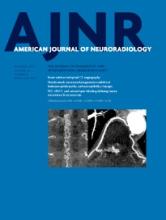Research ArticleAdult Brain
Effect of Collaterals on Clinical Presentation, Baseline Imaging, Complications, and Outcome in Acute Stroke
E.M. Fanou, J. Knight, R.I. Aviv, S.-P. Hojjat, S.P. Symons, L. Zhang and M. Wintermark
American Journal of Neuroradiology December 2015, 36 (12) 2285-2291; DOI: https://doi.org/10.3174/ajnr.A4453
E.M. Fanou
aFrom the Division of Neuroradiology (E.M.F., J.K., R.I.A., S.-P.H., S.P.S., L.Z.), Department of Medical Imaging, University of Toronto and Sunnybrook Health Sciences Centre, Toronto, Ontario, Canada
J. Knight
aFrom the Division of Neuroradiology (E.M.F., J.K., R.I.A., S.-P.H., S.P.S., L.Z.), Department of Medical Imaging, University of Toronto and Sunnybrook Health Sciences Centre, Toronto, Ontario, Canada
R.I. Aviv
aFrom the Division of Neuroradiology (E.M.F., J.K., R.I.A., S.-P.H., S.P.S., L.Z.), Department of Medical Imaging, University of Toronto and Sunnybrook Health Sciences Centre, Toronto, Ontario, Canada
S.-P. Hojjat
aFrom the Division of Neuroradiology (E.M.F., J.K., R.I.A., S.-P.H., S.P.S., L.Z.), Department of Medical Imaging, University of Toronto and Sunnybrook Health Sciences Centre, Toronto, Ontario, Canada
S.P. Symons
aFrom the Division of Neuroradiology (E.M.F., J.K., R.I.A., S.-P.H., S.P.S., L.Z.), Department of Medical Imaging, University of Toronto and Sunnybrook Health Sciences Centre, Toronto, Ontario, Canada
L. Zhang
aFrom the Division of Neuroradiology (E.M.F., J.K., R.I.A., S.-P.H., S.P.S., L.Z.), Department of Medical Imaging, University of Toronto and Sunnybrook Health Sciences Centre, Toronto, Ontario, Canada
M. Wintermark
bDivision of Neuroradiology (M.W.), Department of Radiology, Stanford University, California.

REFERENCES
- 1.↵
- Menon BK,
- Smith EE,
- Modi J, et al
- 2.↵
- Lima FO,
- Furie KL,
- Silva GS, et al
- 3.↵
- Zaidat OO,
- Yoo AJ,
- Khatri P, et al
- 4.↵
- Bang OY,
- Saver JL,
- Kim SJ, et al
- 5.↵
- Souza LC,
- Yoo AJ,
- Chaudhry ZA, et al
- 6.↵
- 7.↵
- Brunner F,
- Tomandl B,
- Hanken K, et al
- 8.↵
- Shuaib A,
- Butcher K,
- Mohammad AA, et al
- 9.↵
- González RG
- 10.↵
- 11.↵
- Smit EJ,
- Vonken EJ,
- van Seeters T, et al
- 12.↵
- Menon BK,
- O'Brien B,
- Bivard A, et al
- 13.↵
- Nambiar V,
- Sohn SI,
- Almekhlafi MA, et al
- 14.↵
- 15.↵
- Tan IY,
- Demchuk AM,
- Hopyan J, et al
- 16.↵
- Bivard A,
- Levi C,
- Spratt N, et al
- 17.↵
- 18.↵
- Eilaghi A,
- Brooks J,
- d'Esterre C, et al
- 19.↵
- Tomsick T
- 20.↵
- Eilaghi A,
- d'Esterre CD,
- Lee TY, et al
- 21.↵
- Murphy A,
- Symons SP,
- Hopyan J, et al
- 22.↵
- Molina CA
- 23.↵
- Bang OY,
- Saver JL,
- Kim SJ, et al
- 24.↵
- Miteff F,
- Levi CR,
- Bateman GA, et al
- 25.↵
- 26.↵
- Campbell BC,
- Christensen S,
- Tress BM, et al
- 27.↵
- Zhu G,
- Michel P,
- Aghaebrahim A, et al
- 28.↵
- Gasparotti R,
- Grassi M,
- Mardighian D, et al
- 29.↵
- Yoo AJ,
- Verduzco LA,
- Schaefer PW, et al
- 30.↵
- Saqqur M,
- Uchino K,
- Demchuk AM, et al
- 31.↵
- Kent DM,
- Hill MD,
- Ruthazer R, et al
- 32.↵
- 33.↵
- Demchuk AM,
- Morgenstern LB,
- Krieger DW, et al
- 34.↵
- 35.↵
- Ribo M,
- Molina C,
- Montaner J, et al
- 36.↵
- Martini SR,
- Kent TA
In this issue
American Journal of Neuroradiology
Vol. 36, Issue 12
1 Dec 2015
Advertisement
E.M. Fanou, J. Knight, R.I. Aviv, S.-P. Hojjat, S.P. Symons, L. Zhang, M. Wintermark
Effect of Collaterals on Clinical Presentation, Baseline Imaging, Complications, and Outcome in Acute Stroke
American Journal of Neuroradiology Dec 2015, 36 (12) 2285-2291; DOI: 10.3174/ajnr.A4453
0 Responses
Jump to section
Related Articles
Cited By...
- Collaterals at angiography guide clinical outcomes after endovascular stroke therapy in HERMES
- Hypoperfusion Intensity Ratio Less Than 0.4 Is Associated with Favorable Outcomes in Unsuccessfully Reperfused Acute Ischemic Stroke with Large-Vessel Occlusion
- Intracerebral arterial blood pressure in the vasculature distal to large vessel occlusions in patients with ischemic stroke: correlation with clinical and imaging parameters
- Hypoperfusion Intensity Ratio and Hemorrhagic Transformation in Patients with Successful Recanalization after Thrombectomy
- Head down tilt 15{degrees} increases cerebral perfusion before recanalization in acute ischemic stroke. A pre-clinical MRI study
- Correlation of Collateral Scores Derived from Whole-Brain Time-Resolved Flat Panel Detector Imaging in Acute Ischemic Stroke
- Association between Early Ischemic Changes and Collaterals in Acute Stroke: A Retrospective Study
- Hypoperfusion intensity ratio for refinement of elderly patient selection for endovascular thrombectomy
- Presentation collateral patterns and outcomes after endovascular thrombectomy for large vessel occlusion stroke
- Hypoperfusion Intensity Ratio Correlates with CTA Collateral Status in Large-Vessel Occlusion Acute Ischemic Stroke
- Management of Acute Ischemic Stroke Due to Large-Vessel Occlusion: JACC Focus Seminar
- Inter- and intraobserver reliability for angiographic leptomeningeal collateral flow assessment by the American Society of Interventional and Therapeutic Neuroradiology/Society of Interventional Radiology (ASITN/SIR) scale
- Guidelines for evaluation and management of cerebral collateral circulation in ischaemic stroke 2017
- Similar Outcomes for Contact Aspiration and Stent Retriever Use According to the Admission Clot Burden Score in ASTER
- Association of clot burden score with radiographic and clinical outcomes following Solitaire stent retriever thrombectomy: analysis of the SWIFT PRIME trial
- Acute Ischemic Stroke Therapy Overview
- Clot Burden Score on Baseline Computerized Tomographic Angiography and Intra-Arterial Treatment Effect in Acute Ischemic Stroke
This article has not yet been cited by articles in journals that are participating in Crossref Cited-by Linking.
More in this TOC Section
Similar Articles
Advertisement











